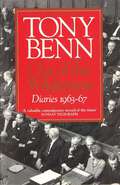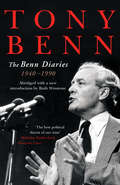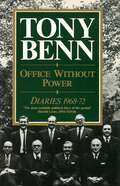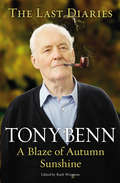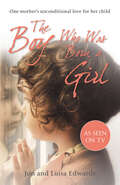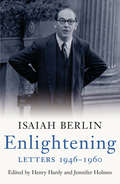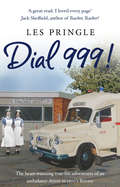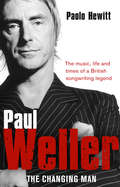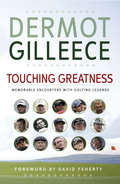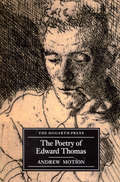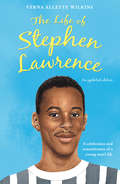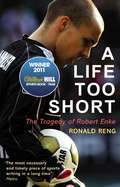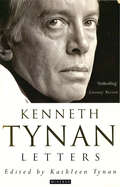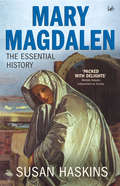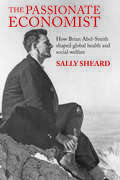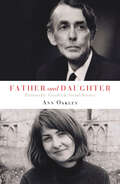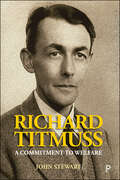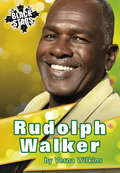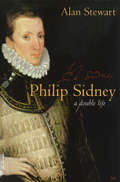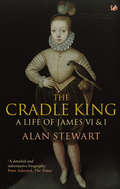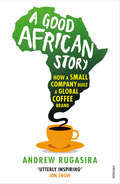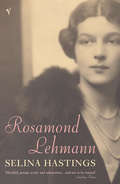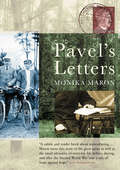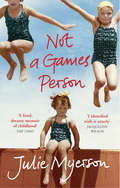- Table View
- List View
Out Of The Wilderness: Diaries 1963-67
by Tony Benn1963 saw Labour's emergence from its 'wilderness years' in Opposition, and the election of Harold Wilson following the unexpected death of Hugh Gaitskell. In the first Wilson government of 1964 Benn was made Postmaster General and became known as an innovator for his introduction of the Giro and arguing for a radical broadcasting policy. After Labour's landslide victory of 1966 he was appointed to the Cabinet as Minister of Technology, but Labour's honeymoon came to an abrupt end in 1967 with the introduction of devaluation, leading to disilliusionment with the Government.Tony Benn's account on his relations with the industrialists, television and press chiefs, the Palace and the diplomatic world as well as trade unionists, civil servants, and his Cabinet colleagues, reveals the workings of our political and economic systems at the highest level.Out of the Wilderness is a unique political record of the 1960s, told by a man who served in five Labour administrations and who today is one of the most experienced figures both in and out of the House of Commons.'No-one interested in the political influence of the Crown, the intrigues of the civil service or the highly traditionalist character of Harold Wilson can afford to ignore it' The Observer
The Benn Diaries: 1940-1990
by Tony BennThe Benn Diaries, embracing the years 1940-1990, are already established as a uniquely authoritative, fascinating and readable record of political life. The selected highlights that form this single-volume edition include the most notable events, arguments and personal reflections throughout Benn's long and remarkable career as a leading politician.The narrative starts with Benn as a schoolboy and takes the reader through his youthful wartime experiences as a trainee pilot, his nervous excitement as a new MP during Clement Atlee's premiership and the tribulations of Labour in the 1950s, when the Conservatives were in firm control. It ends with the Tories again in power, but on the eve of Margaret Thatcher's fall, while Tony Benn is on a mission to Baghdad before the impending Gulf War.Over the span of fifty years, the public and private turmoil in British and world politics is recorded as Benn himself moves from wartime service to become the baby of the House, Cabinet Minister, and finally the Commons' most senior Labour Member.
Office Without Power: Diaries 1968-72
by Tony Benn'The detail of these diaries, and their comprehensive candour, offer unprecedented insights into the personal behaviour of many senior Labour politicians... The most readable political diary of the period' Harold Lever, SpectatorTony Benn's second volume of diaries, which spans the years 1968-72, is a unique record of British politics as observed both from the heart of the Cabinet and the Labour Party.George Brown's spectacular resignation and Cecil King's plot to overthrow Wilson are just two of the events which dominate the opening chapter, and introduce the last years of Labour's increasingly demoralised government.And for the first time in a political diary, Labour's experience of Opposition after the unexpected and shattering defeat of 1970 is revealed. Here, too, are recorded the bitter arguments over the Common Market, in which Tony Benn emerged as the principal advocate of a referendum on Britain's entry - and which foreshadowed the Labour/SDP schism of 1981. The result is a fascinating and invaluable document of the times.'A fascinating insider's account' Ben Pimlott, Standard
A Blaze of Autumn Sunshine: The Last Diaries
by Tony BennIn this final volume of diaries, Tony Benn reflects on the compensations and the disadvantages of old age. With the support of a small circle of friends and his extended family, he continues his activities on behalf of social justice, peace and accountability in public life, to a background of political change and the international economic crisis. Following an illness in 2009 the diaries, kept for over sixty years, cease. Published here alongside these last diaries are Tony Benn’s highly personal insights into the challenges of old age and failing health, of widowhood,and of moving out of the family home after sixty years. Finally, we share in Tony Benn's hopes for the future based on his years of experience and his natural optimism.
The Boy Who Was Born a Girl: One Mother’s Unconditional Love for Her Child
by Jon Edwards Luisa EdwardsBrought up as female for fifteen years, Jon can remember feeling different from other girls since he was only five years old. But it will take years of depression, incessant bullying, self-harm and isolation before he discovers why.When Jon eventually confides to his mother that he feels like a boy, Luisa commits herself unconditionally to helping her child.For Jon, the changes that follow are his path to happiness. But for Luisa, this means coming to terms with the enormous loss of her daughter.
Enlightening: Letters 1946 - 1960
by Isaiah Berlin'People are my landscape', Isaiah Berlin liked to say, and nowhere is the truth of this observation more evident than in his letters. He is a fascinated watcher of human beings in all their variety, and revels in describing them to his many correspondents. His letters combine ironic social comedy and a passionate concern for individual freedom. His interpretation of political events, historical and contemporary, and his views on how life should be lived, are always grounded in the personal, and his fiercest condemnation is reserved for purveyors of grand abstract theories that ignore what people are really like.This second volume of Berlin's letters takes up the story when, after war service in the United States, he returns to life as an Oxford don. Against the background of post-war austerity, the letters chart years of academic frustration and self-doubt, the intellectual explosion when he moves from philosophy to the history of ideas, his growing national fame as broadcaster and lecturer, the publication of some of his best-known works, his election to a professorship, and his reaction to knighthood.These are the years, too, of momentous developments in his private life: the bachelor don's loss of sexual innocence, the emotional turmoil of his father's death, his courtship of a married woman and transformation into husband and stepfather. Above all, these revealing letters vividly display Berlin's effervescent personality - often infuriating, but always irresistible.
Dial 999!
by Les PringleThis is a re-issue of Blue Nights and Long Nights ISBN 9780552158527.Card-playing corpses, unfaithful husbands and 'flying' ladies - life as an ambulance driver in the 1970s was certainly varied ...At the age of twenty-three, Les Pringle decided to escape from office life, broaden his horizons and become an ambulance driver. Little did he realize how broad those horizons would turn out to be.Filled with warmth and humour, Dial 999! takes us back to a time when lonely old ladies could call 999 and have a cup of tea waiting when the drivers turned up for a chat; when learning to drive the ambulance meant going out for one test drive and managing not to hit a pedestrian; and every day brought a glimpse into other people's lives.Gripping, poignant and darkly funny, Dial 999!is an affectionate, warm-hearted look at a world gone by.
Paul Weller - The Changing Man
by Paolo HewittPaolo Hewitt has known Paul Weller since they were both teenagers in the depths of Woking, through his ascent to fame with The Jam, the halcyon years of The Style Council and for all of his critically acclaimed solo career. Hewitt has even been the inspiration for some of Weller's songs - and he has extraordinary in-depth knowledge of the inspiration behind the rest.Once, when Hewitt interviewed Weller for a music magazine, he complained - 'I don't know why people ask me all these questions. All the answers are in my songs.' Largely unnoticed, Weller has used thirty-years of lyrics to explore his personal history and beliefs. Taking as his starting point these lyrics, alongside a lifetime's friendship, Paolo Hewitt shows us the real Paul Weller, the man inside the music.
Touching Greatness: Memorable Encounters with Golfing Legends
by Dermot GilleeceTales of golfing stars and memorable moments from Ireland's best-loved golf correspondent.In almost thirty years as Ireland's leading golf journalist, Dermot Gilleece has met and interviewed numerous heroes of the game.Join Dermot on the course as he looks back over many wonderful years of golf with the greats - from Jack Nicklaus' first game on Irish soil, to sympathetic accounts of the declining skills of iconic golfers such as Seve Ballesteros. Packed with stories and insights about legends from Gene Sarazen, Tom Watson and Tiger Woods to, of course, 'Himself', Christy O'Connor Snr, Touching Greatness offers highlights from Dermot's much-loved column in the Irish Times, as well as more recent observations on the game. There are unmissable insights into illustrious characters from the amateur game, women's golf, Irish involvement in major team competitions like the Ryder Cup, and the history of Irish golfers in the Open, including the double Open and PGA Champion, Padraig Harrington.At turns moving and funny, and always beautifully written, Dermot's tales bring you right onto the fairway as you soak up the very best stories from inside the world of competitive golf.
The Poetry Of Edward Thomas
by Andrew MotionWhen Edward Thomas died at Arras in 1917 few people thought of him as a poet. Yet in the two years before his death, after a lifetime writing prose, Thomas wrote some of the most enduring poems of his day: poems of war, nature, friendship, despair and exultation. Andrew Motion's pioneering study of Thomas' life and achievement is scholarly yet utterly absorbing, combining an account of his struggles as a writer with perceptive readings of individual poems.Andrew Motion's books include a biography, The Lamberts, George, Constant and Kil, and several prize-winning collections of poetry, the most recent of which is Love in a Life. He is currently writing the authorized biography of Philip Larkin.
The Life of Stephen Lawrence
by Verna Allette WilkinsStephen Lawrence was a bright, athletic, young man with high hopes for the future. He lived in south-east London with his parents, younger brother and younger sister. On 22 April 1993, he was brutally murdered while he was waiting for the bus. He was eighteen years old. He didn't know his killers; his killers didn't know him.This is his story. He will be remembered.This paperback edition revised with added material about the trial, the legacy of Stephen Lawrence and a final note from Doreen Lawrence.
A Life Too Short: The Tragedy of Robert Enke
by Ronald RengWINNER OF THE WILLIAM HILL SPORTS BOOK OF THE YEAR WINNER OF THE BRITISH SPORTS BOOK AWARDS FOOTBALL BOOK OF THE YEAR Why does an international footballer with the world at his feet decide to take his own life? On 10 November 2009 the German national goalkeeper, Robert Enke, stepped in front of a passing train. He was thirty-two years old and a devoted husband and father. Enke had played for a string of Europe's top clubs, including Barcelona and Jose Mourinho's Benfica and was destined to become his country's first choice in goal for years to come. But beneath the veneer of success, Enke battled with crippling depression. Award-winning writer Ronald Reng pieces together the puzzle of his friend's life, shedding valuable light on the crushing pressures endured by professional sportsmen and on life at the top clubs. At its heart, Enke's tragedy is a universal story of a man struggling against his demons.‘It should be on every British football fan's reading list’ Metro
Tynan Letters
by Kathleen TynanThe Letters of Kenneth Tynan- drama critic, talent snob, intellectual dandy, inveterate campaigner - provide a record of a soul: written between the ages of 11 and 53, they not only chart the extraordinary parabola of his career but show the constancy of his quest for grace, style and effortless wit.
Mary Magdalen: Truth and Myth
by Susan HaskinsA dramatic, thought-provoking portrait of one of the most compelling figures in early Christianity which explores two thousand years of history, art, and literature to provide a close-up look at Mary Magdalen and her significance in religious and cultural thought.
The Passionate Economist: How Brian Abel-Smith Shaped Global Health and Social Welfare (LSE Pioneers in Social Policy)
by Sally SheardBrian Abel-Smith was one of the most influential expert advisers of the 20th century in shaping social welfare. He was a modern-day Thomas Paine, driven by a strong socialist mission to improve the lives of the poorest. This valuable and accessible book is the first biography of Abel-Smith. It takes a historical perspective to analyse the development of health and social welfare systems since the 1950s, exposing the critical impact of long-running debates on poverty and state responsibility, especially in Britain. This book also provides the first comparative study of how developing countries sought better health and social welfare, enabled by the World Health Organization and other agencies for whom Abel-Smith regularly worked. This book offers an engaging and useful study for students and researchers in health and social policy, history, politics and economics and interested general readers. It will also be essential reading for professionals working in those government ministries and institutions that Brian Abel-Smith helped to shape. LSE Pioneers in Social Policy Brian Abel-Smith, Richard Titmuss and Peter Townsend, all based at the London School of Economics and Political Science, made major contributions to the development of policies on the elderly, health care, law, poverty and welfare in the 20th century. This series of biographies tells the stories of these outstanding individuals: their backgrounds, ideas and work.
Father and Daughter: Patriarchy, Gender and Social Science
by Ann OakleyFather and daughter provides an unique ‘insider perspective’ on two key figures in twentieth-century British social science. Ann Oakley, a highly respected sociologist and best-selling writer, draws on her own life and that of her father, Richard Titmuss, a well-known policy analyst and defender of the welfare state, to offer an absorbing view of the connections between private lives and public work. Using an innovative mix of biography, autobiography, intellectual history, archives, and personal interviews, some of which have not been previously available to the public, she provides a compelling narrative about gender, patriarchy, methodology, and the politics of memory and identity. This fascinating analysis defies the usual social science publications to offer a truly distinctive account which will be of wide interest.
Richard Titmuss: A Commitment to Welfare (LSE Pioneers in Social Policy)
by John StewartThis is the first full-length biography of Richard Titmuss, a pioneer of social policy research and an influential figure in Britain’s post-war welfare debates. Drawing on his own papers, publications, and interviews with those who knew him, the book discusses Titmuss’s ideas, particularly those around the principles of altruism and social solidarity, as well as his role in policy and academic networks at home and overseas. It is an enlightening portrait of a man who deepened our understanding of social problems as well as the policies that respond most effectively to them.
Lockdown Life: The Pandemic Experience for Older Diarists
by Nicola MadgeThe COVID-19 pandemic took many by surprise when it arrived in Britain in early 2020. Daily lives changed dramatically from March with the introduction of unprecedented restrictions and lockdowns. How did people react? This book draws on the diaries of 68 men and women aged 70 and above, capturing their thoughts and experiences over the following months. Although these older diarists considered themselves among the more fortunate at the time, their entries reveal both highs and lows. There were anxieties and frustrations but also much positivity and, often, a reluctance for an over-hasty return to pre-pandemic times. Through these personal and contemporaneous accounts, the book offers a unique contribution to our understanding of the pandemic and its significance in modern social history.
Rudolph Walker Biography (Black Star Series #3)
by Verna Allette WilkinsThe life story of Rudolph Walker, an actor whose career on stage and television in the UK spans 42 years. Includes photographs, illustrations and exclusive interviews. Rudolph was born in Trinidad in the Caribbean. When he was only 20 years old he left the island for London, to embark on a career in theatre. He is best known for his role as Patrick in EastEnders but worked on many popular TV series including Love Thy Neighbour, The Thin Blue Line, Black Silk and The Crouches. He has appeared on stage at the Old Vic, the Young Vic, the Tricycle, the Royal Court and the Theatre Royal among others.
Philip Sidney: A Double Life
by Alan StewartCourtier, poet, soldier, diplomat - Philip Sidney was one of the most promising young men of his age. Son of Elizabeth I's deputy in Ireland, nephew and heir to her favourite, Leicester, he was tipped for high office - and even to inherit the throne. But Sidney soon found himself caught up in the intricate politics of Elizabeth's court and forced to become as Machiavellian as everyone around him if he was to achieve his ambitions. Against a backdrop of Elizabethan intrigue and the battle between Protestant and Catholic for predominance in Europe, Alan Stewart tells the riveting story of Philip Sidney's struggle to suceed. Seeing that his continental allies had a greater sense of his importance that his English contamporaries, Philip turned his attention to Europe. He was made a French baron at seventeen, corresponded with leading foreign scholars, considered marriage proposals from two princesses and, at the time of his tragically early death, was being openly spoken of as the next ruler of the Netherlands.
The Cradle King: A Life of James VI & I
by Alan StewartAs the son of Mary Queen of Scots, born into her 'bloody nest', James had the most precarious of childhoods. Even before his birth, his life was threatened: it was rumoured that his father, Henry, had tried to make the pregnant Mary miscarry by forcing her to witness the assassination of her supposed lover, David Riccio. By the time James was one year old, Henry was murdered, possibly with the connivance of Mary; Mary was in exile in England; and James was King of Scotland. By the age of five, he had experienced three different regents as the ancient dynasties of Scotland battled for power and made him a virtual prisoner in Stirling Castle. In fact, James did not set foot outside the confines of Stirling until he was eleven, when he took control of his country. But even with power in his hands, he would never feel safe. For the rest of his life, he would be caught up in bitter struggles between the warring political and religious factions who sought control over his mind and body. Yet James believed passionately in the divine right of kings, as many of his writings testify. He became a seasoned political operator, carefully avoiding controversy, even when his mother Mary was sent to the executioner by Elizabeth I. His caution and politicking won him the English throne on Elizabeth's death in 1603 and he rapidly set about trying to achieve his most ardent ambition: the Union of the two kingdoms. Alan Stewart's impeccably researched new biography makes brilliant use of original sources to bring to life the conversations and the controversies of the Jacobean age. From James's 'inadvised' relationships with a series of favourites and Gentlemen of the Bedchamber to his conflicts with a Parliament which refused to fit its legislation to the Monarch's will, Stewart lucidly untangles the intricacies of James's life. In doing so, he uncovers the extent to which Charles I's downfall was caused by the cracks that appeared in the monarchy during his father's reign.
A Good African Story: How a Small Company Built a Global Coffee Brand
by Andrew RugasiraSince it was founded in 2003, Good African Coffee has helped thousands of farmers earn a decent living, send their children to school and escape a spiral of debt and dependence. Africa has received over $1 trillion in aid over the last fifty years and yet despite these huge inflows, the continent remains mired in poverty, disease and systemic corruption. In A Good African Story, as Andrew Rugasira recounts the very personal story of his company and the challenges that he has faced – and overcome – as an African entrepreneur, he provides a tantalising glimpse of what Africa could be, and argues that trade has achieved what years of aid have failed to deliver.This is a book about Africa taking its destiny in its own hands, and dictating the terms of its future.
Rosamond Lehmann: A Life
by Selina HastingsThe life of Rosamond Lehmann was as romantic and harrowing as that of any of her fictional heroines. Her first novel, the shocking Dusty Answer, became wildly successful launching her career as a novelist and, just as her novels depicted the tempestuous lives of her heroines, Rosamond's personal life would be full of heartbreaking affairs and lost loves. Escaping from a disastrous early marriage Rosamond moved right into the heart of Bloomsbury society with Wogan Philipps. Later on she would embark on the most important love affair of her life, with the poet Cecil Day Lewis; nine years later he abandoned her for a young actress - a betrayal from which she would never recover. Selina Hastings masterfully creates a portrait of a woman whose dramatic life, work and relationships criss-crossed the cultural, literary and political landscape of England in the middle of the twentieth century.
Pavel's Letters
by Monika MaronTeasing her family's past out of the fog of oblivion and lies, one of Germany's greatest writers asks about the secrets families keep, about the fortitude of ordinary people in extraordinary circumstances, and about what becomes of the individual mind when the powers that be turn against it.Born in a working-class suburb of wartime Berlin, Monika Maron grew up a daughter of the East German nomenklatura, despairing of the system her mother, Hella, helped create. Haunted by the ghosts of her Baptist grandparents, she questions her mother, whose selective memory throws up obstacles to Maron's understanding of her grandparents' horrifying denouement in Polish exile. Maron reconstructs their lives from fragments of memory and a forgotten box of letters. In telling her family's powerful and heroic story, she has written a memoir that has the force of a great novel and also stands both as an elaborate metaphor for the shame of the twentieth century and a life-affirming monument to her ancestors.
Not A Games Person (Yellow Jersey Shorts Ser.)
by Julie MyersonP.E. You either loved it or hated it, looked forward to it or dreaded it, but we've all been forced to do it. Sometimes a note could get you out of it, but the following week there you'd be again, writhing on a cold and dusty gym floor in your underwear. Skinny, timid, knock-kneed Julie Myerson was 'not a games person', according to her teachers. In this touching, funny and occasionally devastating exploration of her childhood, she now asks the question: why not?
